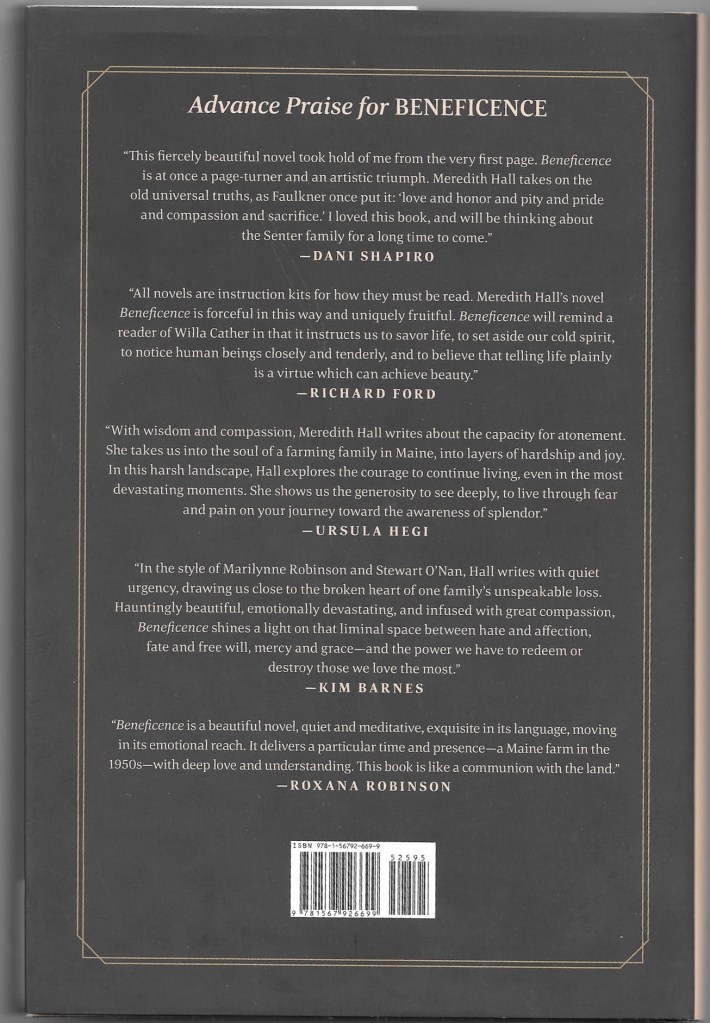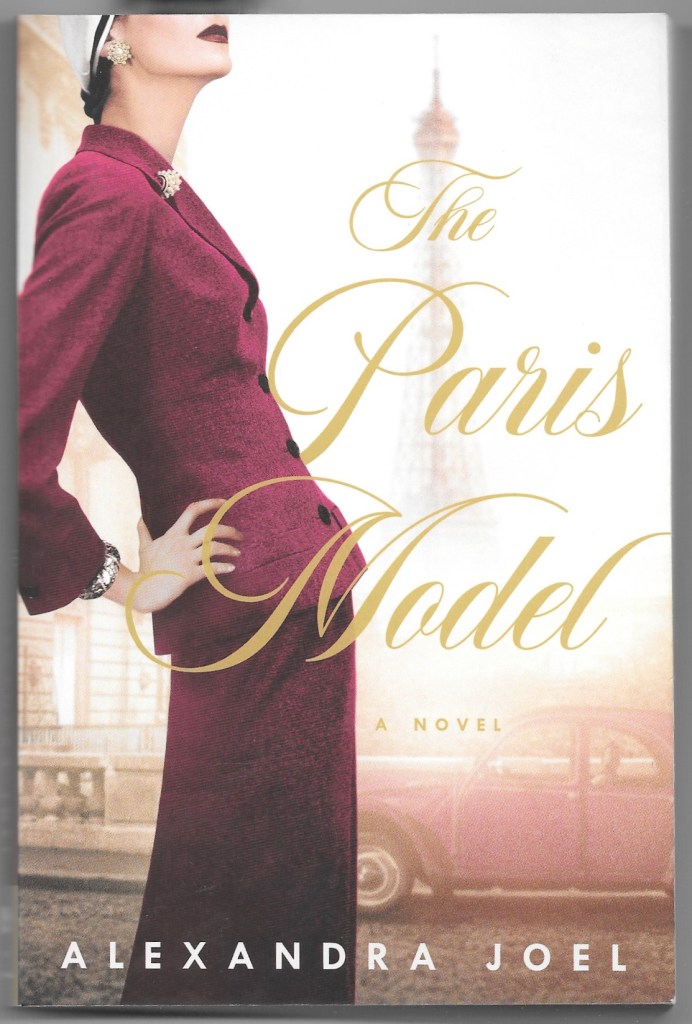Works of fiction which feature some aspect of sewing or fashion are often some of my favorite reading experiences. While I do not necessarily seek them out, if I hear of such a novel, and it’s reviews are positive, then I will add it to my reading queue (similar to my sewing queue!) And sometimes, there is a surprise sewing element in a novel – those are the bonuses.
The last three novels I have read, in quick succession, were all very different, but each one used sewing and/or fashion as foundational premises either for the plot or for character development. So, here are short reviews of each one, in the order in which I read them.
The first novel, Beneficence, by Meredith Hall, came to my attention by a review in The Wall Street Journal Weekend Edition back in the Fall. The subtle role sewing plays in this novel makes it one of those bonus books. Some of the words used to describe this novel, and rightly so, have been “haunting,” luminous,” and “exquisite.” It takes place in Maine (USA) and spans the years from the late 1940s to the early ‘60s. The story is about the Senter family, who owns a dairy farm, and the devastating tragedy which befalls the family of five. Early in the book, one gets the sense of impending doom. At this point, in no way did I have any inkling of the role sewing would have in the development of one of the main characters, Dodie, the daughter. The masterful writing – eerily beautiful, and very affecting – is of such quality that it was only after I had finished the book did I realize how her sewing helped to define Dodie. The sewing references even hint at the blessings ahead for her in the reader’s mind at book’s end. She is a mender, a creator, and a giver of things she has sewn. She is wise beyond her years. She is a character I will long remember. The book is a masterpiece.
One word of warning, however, is necessary for this book. Parts of it are very difficult emotionally to read. I cried a lot reading it, perhaps crying the most at the book’s end when grace and wisdom finally replace anguish for each of the Senters. If you are feeling in any way fragile right now, then plan to read this book at another, more secure time.
Feeling emotionally drained (but fulfilled) after reading Beneficence, I wanted something light-hearted and fun. And like a blessing, this book came to me as a Christmas gift from my daughter, Susanna.
The Women in Black, by Madeline St. John, is set in the early 1950s in Sydney, Australia. It follows four women (actually 3 women and one 16-year-old girl) who work at Goode’s Department Store in Fine Dresses and Model Dresses (Model Dresses being the most expensive.) The time of year is December, when cocktail and party dress buying is at a frenzy! Patty and Fay are in the fine dresses, Magda manages the Model Gowns, and Lisa is a temporary hire who helps out wherever she is needed. In many ways, however, it is Lisa’s story. Magda takes a loving interest in her, and when Lisa is exposed to the confectionary frocks in Model Gowns, she comes alive. She particularly has her eye on one dress, which is called “Lisette.” And when she finally has the opportunity to try the dress on, this is what transpires:
“Lisette was, of course, everything which could have been dreamed; like all the great works of the French couture, it was designed to look beautiful not simply as a thing in itself, but as the clothing of a female form. It took on then the property of vitality and movement, that is, of rhythm: it became finally incarnate. Lisa stood, overwhelmed, staring into the great cheval glass. . . . The frock changed her absolutely; the revelation which had come upon her when she had first been shown the Model gowns was now complete.”
What a fun book, written by someone (sadly now deceased) who understood the transformative power of dress and dresses. Treat yourself and read this book!
Just the title of the third book I am sharing is intriquing enough to catch your attention.
Based loosely on a true story, but definitely a work of fiction, The French Model, by Alexandra Joel, is the story of a stunningly beautiful young Australian woman who makes her way to Paris and becomes a model in Christian Dior’s House in post-war France. In leaving Australia, she is escaping not only from an unhappy marriage, but also from revelations about her past which make her question her identity and all those she has ever loved. This book has it all: mystery, espionage, love, fashion, friendship, sacrifice, sex, “very important person” sightings, political intrigue, history, and courage – all in a complex story line which will keep you on the edge of your seat. The writing is lovely and descriptive, the main characters endearing. Some of the story is a bit contrived – or unbelievable – but I was generally able to overlook those parts to enjoy the larger storyline. And I loved the emphasis on the workings of the House of Christian Dior. Anyone who loves vintage fashion – or historical fiction set at the end of World War II – should find escaping into this story a happy place to be.
One final observation about these three books. The dust jackets are works of art. Not unlike a perfectly fitted and flattering dress, each one is so perfectly evocative of what lies within, capturing the very essence of the books they adorn. As I look again and again at each one, it takes me back to those stories, those places and those indelible characters which gave me so much reading pleasure.







A Book Review: The Dress Diary of Mrs. Anne Sykes – Secrets from a Victorian Woman’s Wardrobe, by Kate Strasdin.
Every once in a while, I find myself having fallen under the spell of a particularly noteworthy and engaging book. Such was my fate with this remarkable story of an Englishwoman (1816 -1890) and her journal of fabric swatches, saved from her own life and collected from family, friends, and acquaintances over the course of decades, beginning in September of 1838.
With over 1200 fabric entries, the diary – or journal – gradually revealed its secrets to the author, a fashion historian, who painstakingly transcribed the often sparse notations accompanying each fabric sample, piecing together the fascinating life and times of Anne Burton Sykes. The research is meticulous, and the author, Kate Strasdin, shares her eureka moments which allowed her to expand not only Anne’s life, but those of her friends and family as well. Written in an engaging style, this non-fiction book often reads like a novel, a wonderful story of love, friendship, adventure, and vibrant personalities.
There is so much to learn here about Anne’s life in the larger context of world history and events, but it is the personal experiences and expressions which spoke so loudly to me. Yes, there are many details which, by the nature of the journal, must be extrapolated and surmised, which the author is careful to note. But the picture of Anne – and her husband Adam – which evolves is one of two very likeable people, engaged in their community, industrious and thoughtful, friendly and adventurous, and undoubtably well-dressed.
The first entries in the journal, of Anne’s wedding attire, were actually placed and annotated by Adam. He was the one to give Anne the journal on their wedding day. He refers to her as “my charming Anne.” Not beautiful, not sweet, not dear, but “charming.” That single selection of adjective spoke volumes to me about each of them.
She also must have been brave, enduring a four-month sea voyage from northern England to Singapore, where Adam’s business took them two years after their marriage. There they built a life among other English-speaking neighbors and acquaintances, in the stifling heat and humidity of the south China sea. After seven years in Singapore, they went on to Shanghai for two years (where the diary goes silent for the duration), and then back to England.
Anne’s friendships with other women throughout her life are apparent in the swatches she receives from so many in her circle. The exchange of gifts and tokens of friendship take form in dress-goods (cotton, wool, silk), ribbons, pieces of lace, and snippets of sashes. There appeared to be a remarkable camaraderie among all ages and between the sexes.
The author has done a masterful job in deciphering the life and persona of Mrs. Anne Sykes through so many diverse fabric swatches. Anne’s kindness, her circumspection, her devotion to family and friends, and her small place in history make for a wonderful, enlightening story. I am very grateful to have had the opportunity to read and savor this book.
11 Comments
Filed under Book reviews, Fashion commentary, Fashion history, Uncategorized, Vintage fabric
Tagged as Book reviews